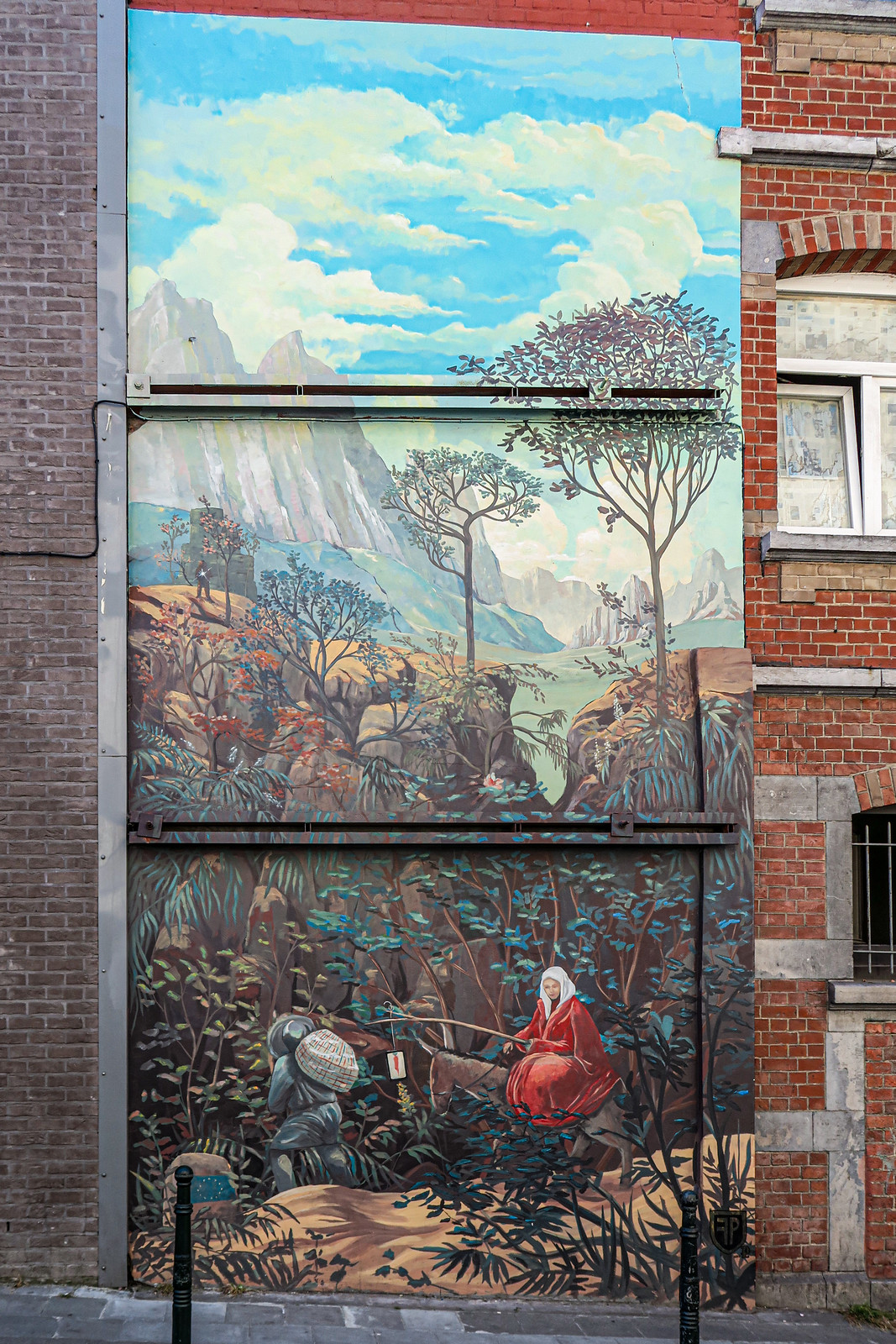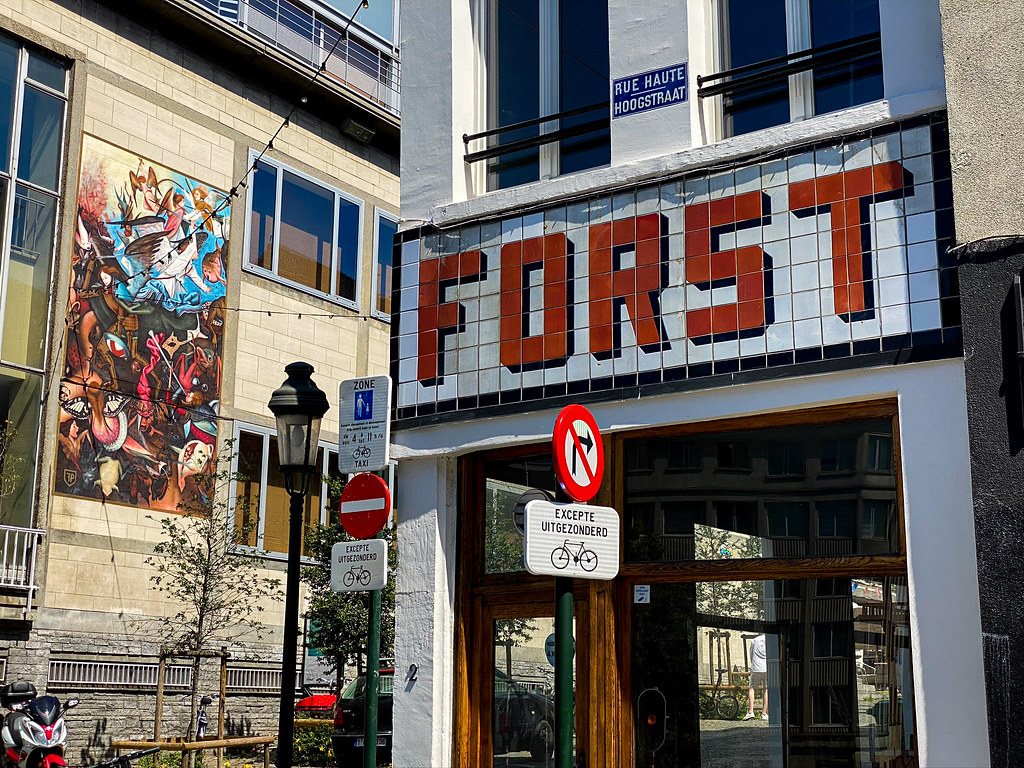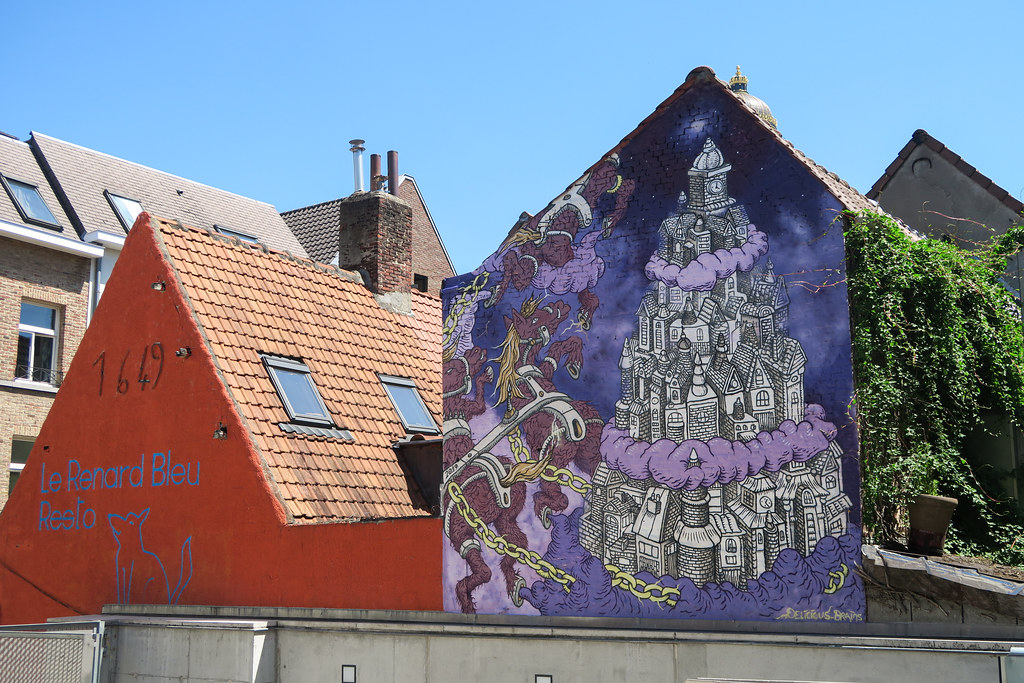To celebrate the 450th anniversary of Pieter Bruegel the Elder’s death, the city of Brussels hired a collective of artists known under the name FarmProd to to pay homage to the painter and compose, through the Marolles neighborhood, a street art itinerary containing 12 murals freely inspired by the work of the master. This artistic walk completes the program of exhibitions devoted this year to Bruegel, in the capital, and across Belgium.
Starting with the Bruegel street art tour
A great place to begin your itinerary is at the Église Notre-Dame de la Chapelle (Church of Our Lady of the Chapel) just two minutes walk from the actual start of the street art tour. Right outside of the church where he was both married and buried, you will find a statue of Bruegel recently sculpted by Tom Frantzen. Bruegel’s history is closely linked to that of Brussels, and in particular, to the Marolles district where the tour takes place. It was indeed while living at 132 rue Haute from 1563 onward that he produced his most famous paintings.

The sculpture represents the Bruegel in front of an imaginary canvas only delimited by a broken frame leaving room for the imagination and creativity of the passersby. This window is called “the open window”. It represents the open mind of the Renaissance humanist.
Here above in a close-up, you can see better the little monkey on his shoulder wearing a funnel on his head. This was added to symbolizes the satirical spirit of the artist.
Fred Lebbe here made a faithful reproduction of the famous Bruegel painting “The fall of the rebel angelsâ€. You can also find some of his characters in the Notre-Dame de la Chapelle church, which is right next door, and where Bruegel is buried.
“I chose a particular part of this piece, as its pictorial universe speaks to me. My challenge was to interpret it as accurately as possible with the spray painting technique. It was a way to pay tribute to Bruegel’s technical prowess”
Artist Fred Lebbe on his “Fall of the Rebel Angels” mural
The Patienta (Patience in English) mural is a very colorful and abstract rendition by the Hell’O Collective of the painting of the same name from Bruegel.

At first, I thought it would take some wild imagination to be able to recognize anything in this mural from Bruegel’s 1556 painting. But the Hell’O Collective explains below.
“Patientia by Bruegel is an allegory of patience ( attempting to concretise abstract ideas), our intention was to work on a counter-allegory. To isolate elements of the original work that seemed interesting to us and translate them into simple, balanced and colorful geometric shapes.â€
The Hell’O Collective went on to explained about the Mural
Les Crayons Collective have also invited themselves into Bruegel’s universe with not one but two murals at the end of rue du Miroir. The one above is inspired his “Pride†engraving.
The tree, where you can see the character hung, is taken from Bruegel’s painting “The Peasant and the Nest-Robberâ€. The exact meaning of the original is, to this date is still the subject of debate.
Here as seen above and below, artist Nelson Dos Reis has chosen to represent only one of the fantastic creatures in the original Sloth drawing by Bruegel, made in 1557.
“I have often been drawn by characters that are a little flawed or in anti-hero roles. Here, I wanted to pay tribute to Bruegel’s art in my own way by focusing on just one of his multiple creatures, isolating it from it’s context in the scene.â€
Nelson Dos Reis goes on to explain about the mural
If you take the time to look up on 140 rue Blaes, you will discover a friendly little donkey depicted studying a book. Alexis Alexis Corrand made here a great rendition of Bruegel The Ass at School drawing.
“I chose this piece, of a teacher in the middle of a rowdy class; and I focused on just one character: The donkey which is seen coming out of a window. I positioned my donkey to give the illusion that it was coming out of the wall.â€
Alexis Corrand goes on to explain about the choices in his mural
Piotr Szlachta reveals his personal interpretation of Joseph & Mary’s “Flight to Egypt†on 9 rue des Capucins. The Brussels artist, Born in Warsaw, Poland retains the classic Bruegel style, while adding a few modern touches to the painting like an EU flag. The artist chose this painting, located in one of the most multicultural neighborhoods of Brussels, to remind people that the migrations of populations has always been occurring since the beginning of times.

Here above you can see the Landscape with the Flight into Egypt” mural in it’s entirety
Just on the corner of Place du Jeu de Balle going onto rue du Chevreuil is where you will find the mural by Belgian artist Arno Debal aka Arno 2bal. His rendition is very faithful to the original self-portrait of Bruegel made in 1682 but background has been cleverly modified to include words common expressions and puns in the local “Brusseleir dialect“. You can better make out the text in the picture below.

A list of typical Brusseleir expressions is shown in the background in alphabetic order in the picture above
Easy to miss walking down rue des renards as it’s somewhat hidden in the courtyard of the Bruegel Cultural Center, you will find a beautiful interpretation of one of Bruegel’s most famous paintings “The Tower of Babel” by artist Delicious Brains . The Swedish artist of his real name Kim Deman brings a colorful contrast to the original 1563 painting.

“For me, Babylon represents a symbol of oppression. A dark world where power thirsty men seeking to rule over others by force from one gigantic tower. Sadly, this is still the foundation of our society today. Even though Bruegel painted this many centuries ago, the theme is still very relevant today.â€
Artist Kim Demane of Delicious Brains (SE)

“The Parable of the Good Shepherd” mural by 6 Artists of the Farm Prod collective Arno 2bal is found at rue des Renards, 38-40 , Brussels, Belgium
Going up on rue Haute, at the corner of rue des renards, you will find the mural created collectively by 6 members of FarmProd: Alexis Corrand, Arno Debal, Nelson Dos Reis, Fred Lebbe, Piotr Szlachta & Gui Tar.

Inspired by “The Parable of the Good Shepherd” of Pieter Bruegel the Elder, here above by looking more closely you will notice that the sheep in the original work has been replaced by a fox, a nod to the name of the street, but also to this emblematic animal of Brussels.
At the corner of rues Haute and La Rasière, you will find one of Bruegel’s emblematic works “the hunters in the snow”. But why exactly did artist Gui Tar turn dogs into rats?
“I was immediately attracted by the composition and surrealist atmosphere of this scene. I decided to focus on the hunters and their hounds. By retaining the compositional elements, I transformed the subject and the graphic aesthetic. The scene depicts rat hunters pursued by their prey, all in a fluffy universe which resembles a dream. It’s a kind of surreal allegory of the absurd.â€
Artist Guillaume Desmarets aka Gui Tar

“The Wedding Dance” mural by artist Lazoo is found at rue Haute 399, Brussels, Belgium
The tour ends with one final mural on rue Haute 399. French artist Yann Lazoo, took his his inspiration from Bruegel’s painting “The Wedding Dance” by transforming its protagonists into more contemporary urban characters from hip-hop culture.
















